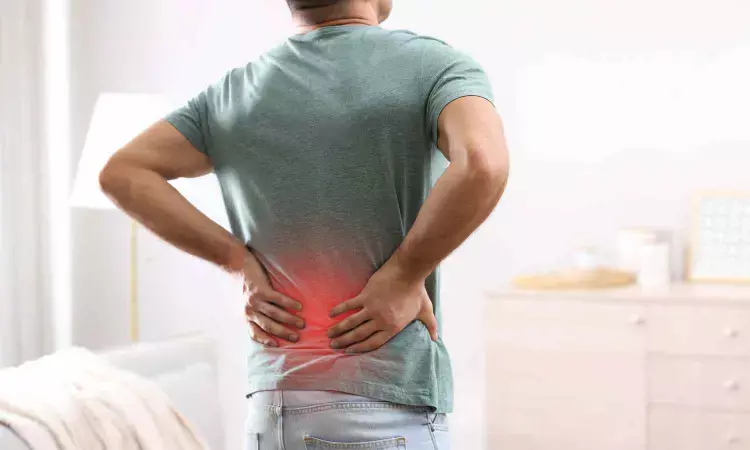- Home
- Medical news & Guidelines
- Anesthesiology
- Cardiology and CTVS
- Critical Care
- Dentistry
- Dermatology
- Diabetes and Endocrinology
- ENT
- Gastroenterology
- Medicine
- Nephrology
- Neurology
- Obstretics-Gynaecology
- Oncology
- Ophthalmology
- Orthopaedics
- Pediatrics-Neonatology
- Psychiatry
- Pulmonology
- Radiology
- Surgery
- Urology
- Laboratory Medicine
- Diet
- Nursing
- Paramedical
- Physiotherapy
- Health news
- Fact Check
- Bone Health Fact Check
- Brain Health Fact Check
- Cancer Related Fact Check
- Child Care Fact Check
- Dental and oral health fact check
- Diabetes and metabolic health fact check
- Diet and Nutrition Fact Check
- Eye and ENT Care Fact Check
- Fitness fact check
- Gut health fact check
- Heart health fact check
- Kidney health fact check
- Medical education fact check
- Men's health fact check
- Respiratory fact check
- Skin and hair care fact check
- Vaccine and Immunization fact check
- Women's health fact check
- AYUSH
- State News
- Andaman and Nicobar Islands
- Andhra Pradesh
- Arunachal Pradesh
- Assam
- Bihar
- Chandigarh
- Chattisgarh
- Dadra and Nagar Haveli
- Daman and Diu
- Delhi
- Goa
- Gujarat
- Haryana
- Himachal Pradesh
- Jammu & Kashmir
- Jharkhand
- Karnataka
- Kerala
- Ladakh
- Lakshadweep
- Madhya Pradesh
- Maharashtra
- Manipur
- Meghalaya
- Mizoram
- Nagaland
- Odisha
- Puducherry
- Punjab
- Rajasthan
- Sikkim
- Tamil Nadu
- Telangana
- Tripura
- Uttar Pradesh
- Uttrakhand
- West Bengal
- Medical Education
- Industry
Walking brings huge benefits for low back pain, study finds

Adults with a history of low back pain went nearly twice as long without a recurrence of their back pain if they walked regularly, a world-first study has found.
About 800 million people worldwide have low back pain, and it is a leading cause of disability and reduced quality of life.
Repeated episodes of low back pain are also very common, with seven in 10 people who recover from an episode going on to have a recurrence within a year.
Current best practice for back pain management and prevention suggests the combination of exercise and education. However, some forms of exercise are not accessible or affordable to many people due to their high cost, complexity, and need for supervision.
A clinical trial by Macquarie University’s Spinal Pain Research Group has looked at whether walking could be an effective, cost-effective and accessible intervention.
The trial followed 701 adults who had recently recovered from an episode of low back pain, randomly allocating participants to either an individualised walking program and six physiotherapist-guided education sessions over six months, or to a control group.
Researchers followed the participants for between one and three years, depending on when they joined, and the results have now been published in the latest edition of The Lancet.
The paper’s senior author, Macquarie University Professor of Physiotherapy, Mark Hancock, says the findings could have a profound impact on how low back pain is managed.
“The intervention group had fewer occurrences of activity limiting pain compared to the control group, and a longer average period before they had a recurrence, with a median of 208 days compared to 112 days,” Professor Hancock says.
“Walking is a low-cost, widely accessible and simple exercise that almost anyone can engage in, regardless of geographic location, age or socio-economic status.
“We don’t know exactly why walking is so good for preventing back pain, but it is likely to include the combination of the gentle oscillatory movements, loading and strengthening the spinal structures and muscles, relaxation and stress relief, and release of ‘feel-good’ endorphins.
"And of course, we also know that walking comes with many other health benefits, including cardiovascular health, bone density, healthy weight, and improved mental health.”
Lead author Dr Natasha Pocovi says in addition to providing participants with longer pain-free periods, the program was very cost-effective.
“It not only improved people’s quality of life, but it reduced their need both to seek healthcare support and the amount of time taken off work by approximately half,” she says.
“The exercise-based interventions to prevent back pain that have been explored previously are typically group-based and need close clinical supervision and expensive equipment, so they are much less accessible to the majority of patients.
“Our study has shown that this effective and accessible means of exercise has the potential to be successfully implemented at a much larger scale than other forms of exercise.”
To build on these findings, the team now hopes to explore how they can integrate the preventive approach into the routine care of patients who experience recurrent low back pain.
Reference:
Natasha C Pocovi, Prof Chung-Wei Christine Lin, Prof Simon D French, Petra L Graham, Johanna M van Dongen, Prof Jane Latimer, Effectiveness and cost-effectiveness of an individualised, progressive walking and education intervention for the prevention of low back pain recurrence in Australia (WalkBack): a randomised controlled trial, The Lancet, https://doi.org/10.1016/S0140-6736(24)00755-4.
Dr Kamal Kant Kohli-MBBS, DTCD- a chest specialist with more than 30 years of practice and a flair for writing clinical articles, Dr Kamal Kant Kohli joined Medical Dialogues as a Chief Editor of Medical News. Besides writing articles, as an editor, he proofreads and verifies all the medical content published on Medical Dialogues including those coming from journals, studies,medical conferences,guidelines etc. Email: drkohli@medicaldialogues.in. Contact no. 011-43720751


